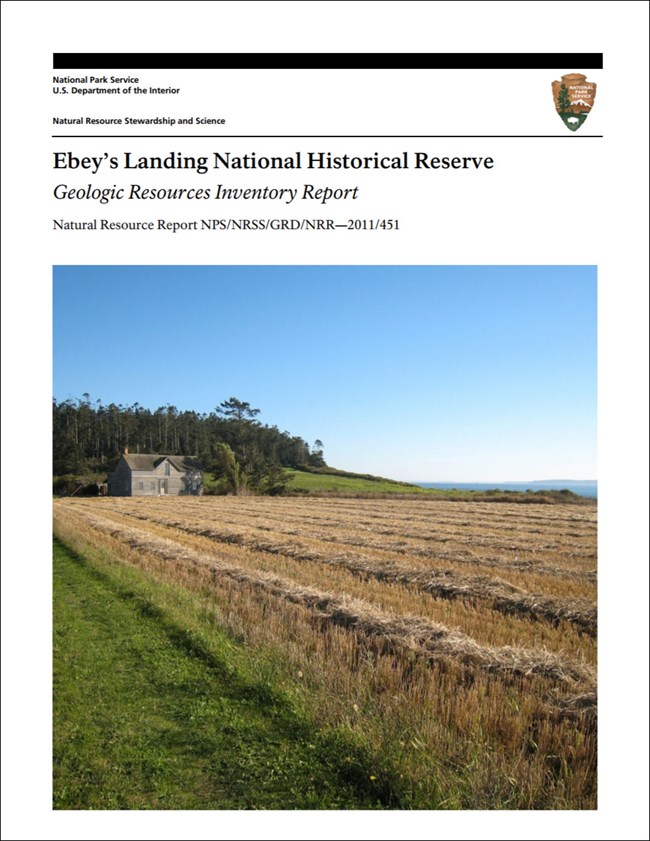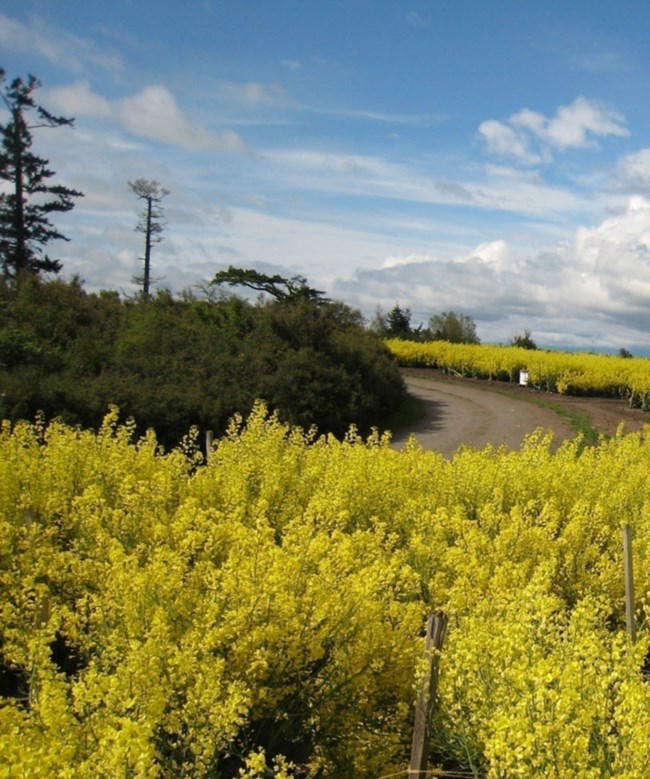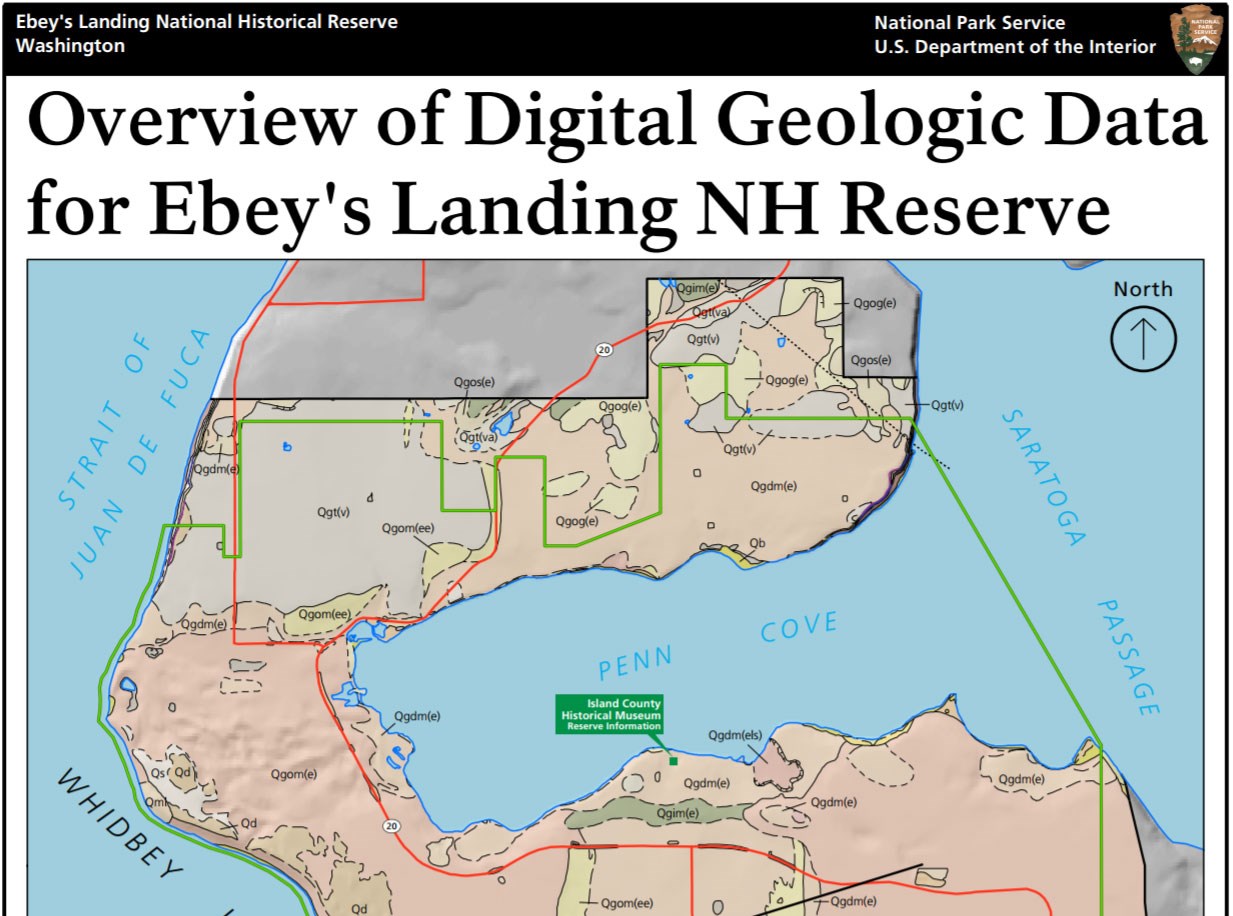Last updated: June 17, 2024
Article
NPS Geodiversity Atlas—Ebey’s Landing National Historical Reserve, Washington
Geodiversity refers to the full variety of natural geologic (rocks, minerals, sediments, fossils, landforms, and physical processes) and soil resources and processes that occur in the park. A product of the Geologic Resources Inventory, the NPS Geodiversity Atlas delivers information in support of education, Geoconservation, and integrated management of living (biotic) and non-living (abiotic) components of the ecosystem.

Introduction
Ebey’s Landing National Historical Reserve has the distinction of being the first national historical reserve in the National Park System. Authorized in 1978, the reserve preserves and protects an unbroken historical record of Puget Sound exploration and settlement from the 19th century to the present. Located on Whidbey Island, the largest island in the conterminous United States, Ebey’s Landing National Historical Reserve lies about 43 km (27 mi) north of Seattle. Members of the central Whidbey Island community work together with local, state, and federal governments to manage the reserve and to balance the needs of the community with the protection of the reserve’s resources.
Geologic Setting
The reserve lies in Washington’s Puget Lowland physiographic province, a broad, low-lying region between the Cascade Range to the east and the Olympic Mountains to the west. Like the San Juan Islands, the geomorphic features on Whidbey Island were shaped by continental glaciers that advanced over the Puget Lowland during the Pleistocene ice ages. Glacial and nonglacial units of clay, silt, sand, and gravel record the advance and retreat of several glaciers through the lowland. Ice from the most recent glaciation covered the area approximately 18,000 years ago. At the height of this glaciation, Whidbey Island was covered with about 1,250 m (4,100 ft) of ice. Upon melting, the glaciers left a mixture of unconsolidated sediments that reflect a variety of depositional environments including glaciomarine seafloors, deltas, fluvial outwash plains, and ice-margin and sub-glacial environments.
Whidbey Island lies in an active tectonic area, and coseismic tectonic land-level change has been documented within Ebey’s Landing National Historical Reserve. The northwest-trending Southern Whidbey Island fault lies 10 km (6 mi) southeast of Admiralty Head, which forms the southwestern corner of the reserve. This fault separates two major crustal blocks and has been the source of several historic shallow earthquakes. Faults identified outside of the reserve indicate fault movement as recently as 1850 C.E. (Common Era; preferred to “A.D.”). Most of Ebey’s Landing National Historical Reserve is pastoral, but tectonic land-level changes and ground shaking from earthquakes are potential hazards to the historic buildings in Coupeville, the second oldest town in Washington and the commercial center of the reserve. Coupeville is built over clayey glaciomarine drift, which may not provide a firm foundation in the event of an earthquake.
Glaciers shaped the landforms on Whidbey Island and laid the foundation for the cultural history preserved at Ebey’s Landing National Historical Reserve. For example, the bluffs along the western shoreline provided an excellent vantage point for Fort Casey, built in the late 1890s and currently preserved as a state park. Glacial till formed the rolling hills and agricultural lands of the San de Fuca Uplands. The clayey glaciomarine drift and gentle slopes left behind by the ice provided rich soils for the crops grown by American Indians and present-day farmers in Ebey’s Prairie, located in the central portion of the reserve. Smith Prairie formed as a well-drained, elevated, and flat glaciolacustrine delta surface that was an attractive site for the location of the Coupeville airfield. The embayment of Penn Cove, which provides a naturally sheltered harbor for Coupeville and is an ideal location for the cultivation of mussels, resulted from fast-flowing, pressurized subglacial meltwater that carved a trough into the sediments between Coupeville and the uplands to the north. The formation of kettle ponds by the melting of stagnant ice shaped the landscape in the Kettle and Pratt Woodlands surrounding Fort Ebey State Park.

Photograph by Ashley Davis, courtesy of Lys Opp-Beckman.
Geologic Features and Processes
The diverse physical and visual landscapes within the small geographic area of Ebey’s Landing National Historical Reserve are closely tied to the primary purpose of the reserve, which is to preserve and protect the cultural landscape. The reserve contains excellent examples of both glacial and post-glacial features and processes. Together with the distinctive climate, rain shadow location, soils, and maritime influence, these geologic features have helped shape the historical landscape of Whidbey Island and the unusual diversity of plant and animal species, communities, and habitats (National Park Service 2006).
Geologic features and processes identified in the park’s Geologic Resource Inventory include:
-
Glacial Features and Processes
-
Post-glacial Features and Processes
-
Paleontological Resources
-
Landscape Character Areas
Paleontological Resources
All NPS fossil resources are protected under the Paleontological Resources Preservation Act of 2009 (Public Law 111-11, Title VI, Subtitle D; 16 U.S.C. §§ 470aaa - 470aaa-11).
Regional Geology
Ebey’s Landing National Historical Reserve is a part of the Pacific Border Physiographic Province and shares its geologic history and some characteristic geologic formations with a region that extends well beyond park boundaries.
- Scoping summaries are records of scoping meetings where NPS staff and local geologists determined the park’s geologic mapping plan and what content should be included in the report.
- Digital geologic maps include files for viewing in GIS software, a guide to using the data, and a document with ancillary map information. Newer products also include data viewable in Google Earth and online map services.
- Reports use the maps to discuss the park’s setting and significance, notable geologic features and processes, geologic resource management issues, and geologic history.
- Posters are a static view of the GIS data in PDF format. Newer posters include aerial imagery or shaded relief and other park information. They are also included with the reports.
- Projects list basic information about the program and all products available for a park.
Source: NPS DataStore Saved Search 2814. To search for additional information, visit the NPS DataStore.
A NPS Soil Resources Inventory project has been completed for Ebey’s Landing National Historical Reserve and can be found on the NPS Data Store.
Source: NPS DataStore Saved Search 2825. To search for additional information, visit the NPS DataStore.
GRI Geology Image Gallery

Related Links
Related Articles
Ebey’s Landing National Historical ReserveNational Park Service Geodiversity Atlas
The servicewide Geodiversity Atlas provides information on geoheritage and geodiversity resources and values within the National Park System. This information supports science-based geoconservation and interpretation in the NPS, as well as STEM education in schools, museums, and field camps. The NPS Geologic Resources Division and many parks work with National and International geoconservation communities to ensure that NPS abiotic resources are managed using the highest standards and best practices available.

